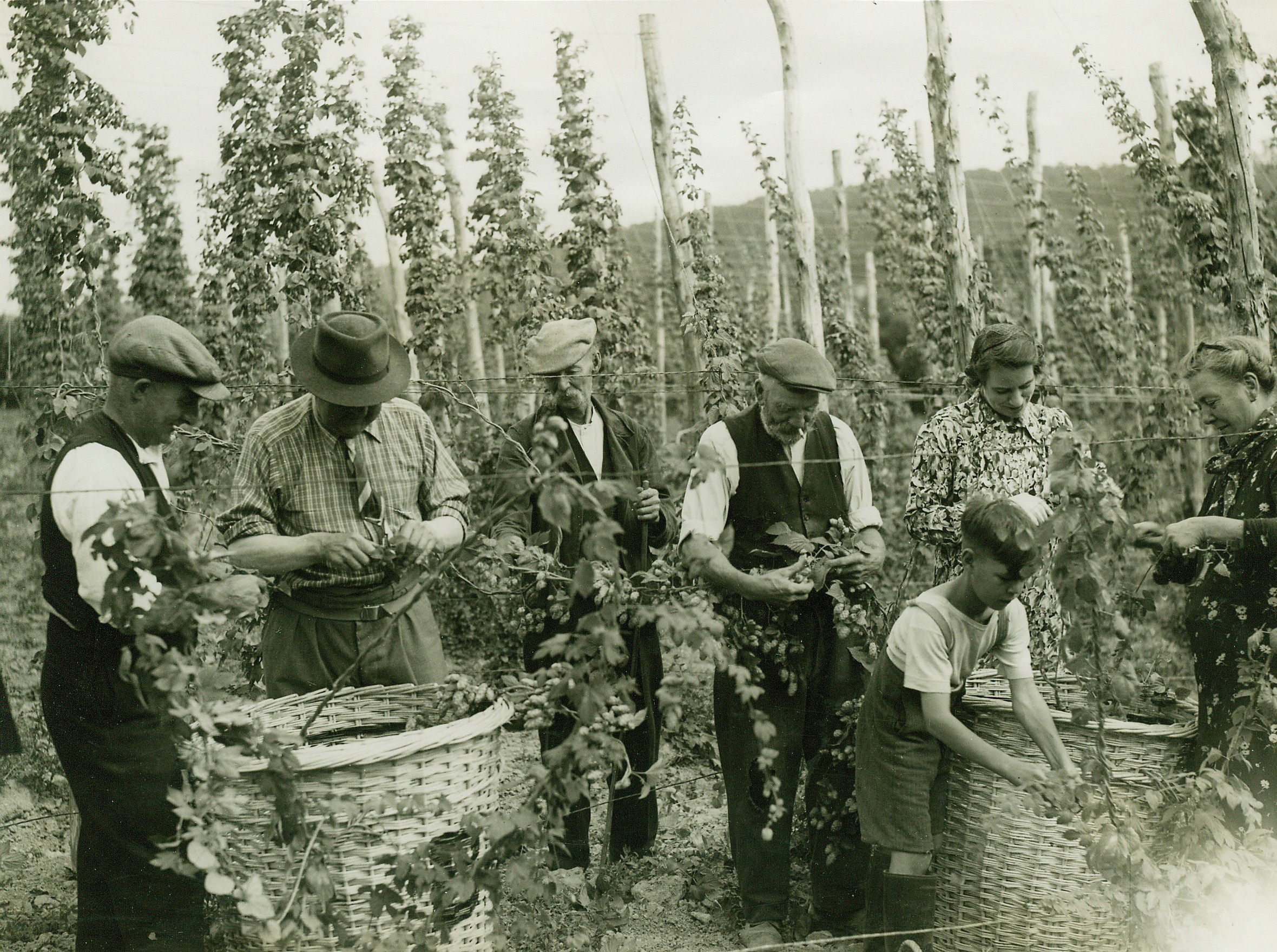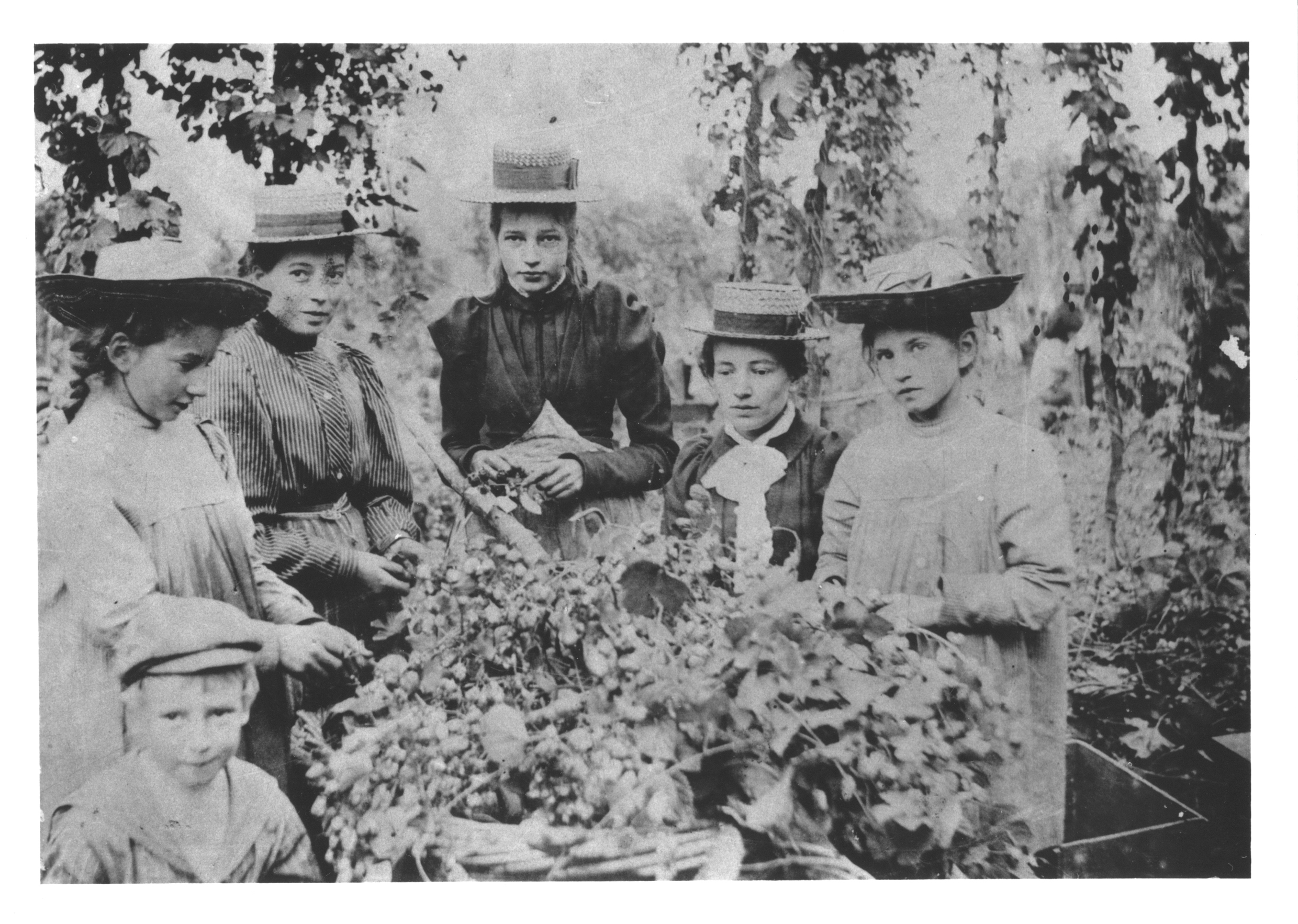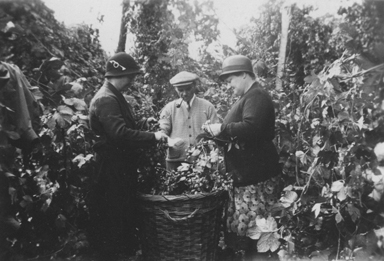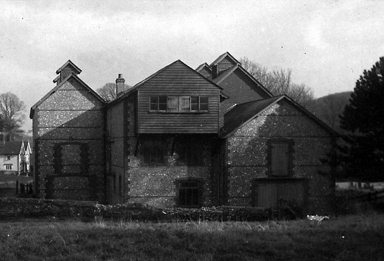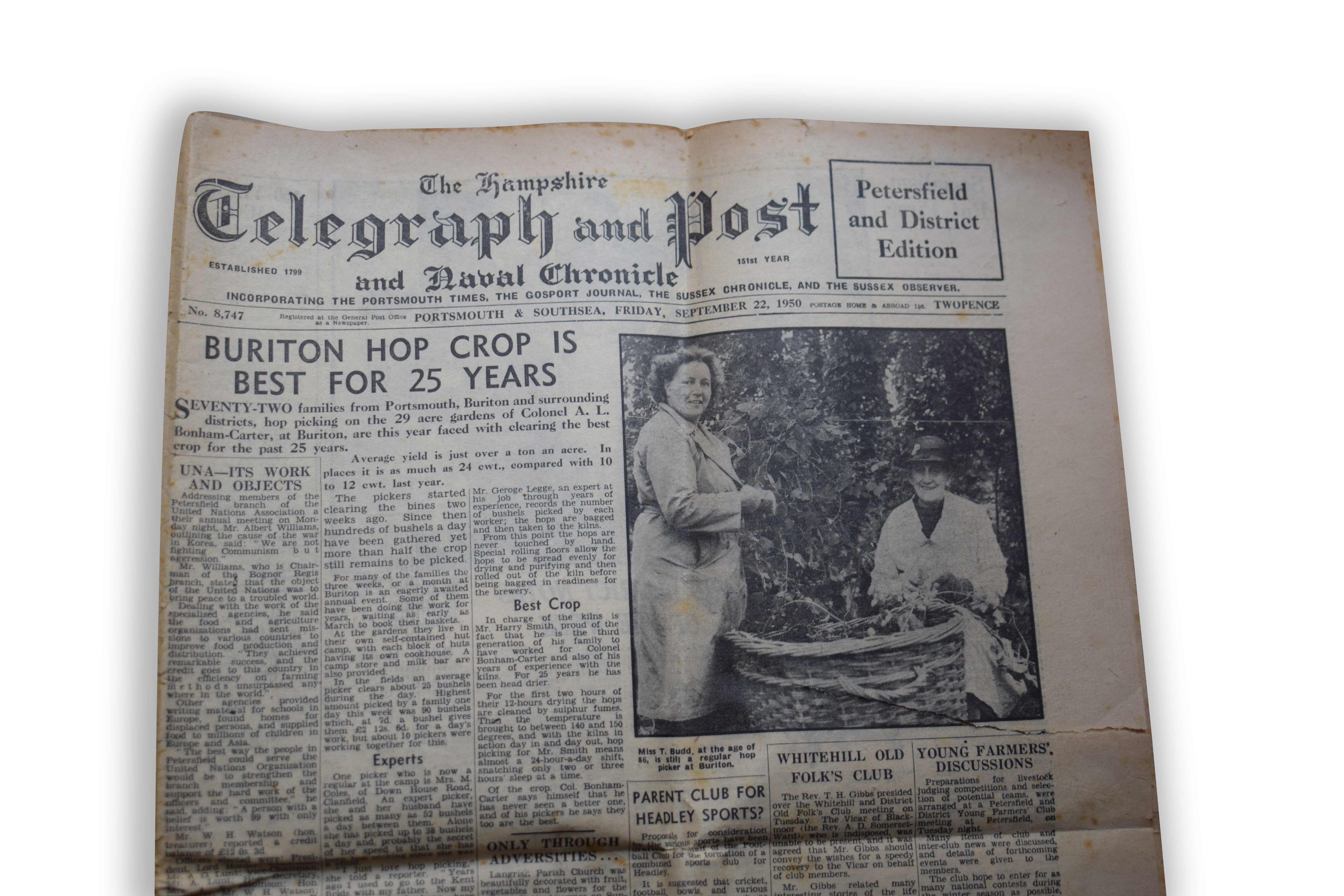Regular Newspaper Features
In most years, one or more of the local newspapers would include a feature on hop-picking in Buriton or Weston. Here is one reporter’s account from 1937 :
“I was welcomed by many families of Portsmouth pickers in a place known to them all as ‘Buriton Garden City’. There is a colony of Portsmouth men, women and children at the Bonham-Carter hop gardens. Some families have been picking here for three generations.
For a fortnight every year they join the local pickers (who call them ‘out-comers’).
“Mr Percy W Smith is the farm bailiff. He told me something about hop-pickers. How they start at 7am and finish at about 6pm. How they entertain themselves in the huts supplies for their accommodation with wireless sets and gramophones and lead a little colonial life of their own. How the picking is a family affair, mother, father and the children all joining in.
“I found the pickers using many terms that I had to have interpreted. A ‘poke’, for instance, is a bag in which the hops are taken to the drying kilns, where they are purified by sulphur fumes and dried. There they are hand-pressed into ‘pockets’ (larger and stronger sacks) and are then ready for the brewers.
“I met a ‘pole-puller’ whose title is derived from the old days when the vines in Buriton were trained up poles instead of on wires as they are now. A ‘monkey’ is part of the vine that is left hanging high up on the wires after the rest of the vine has been tugged down. It is the pole-puller’s task to bring these down with a special hooked pole.
“The pickers get 3d a bushel for one size of hops and 1s for five bushels of another size. Each picker averages 16 or 26 bushels a day according to which size of hop he is picking.”
Local Recollections
Much of the information in this note has been provided by George ‘Sonner’ Legg of Glebe Road, Buriton. Mr Legg worked on the Buriton Manor Estate all his working life and was, for many years, head-dryer in the hop kilns, learning his trade from Harry Smith.
Here are some other recollections of local hop-growing and hop-picking:
Mrs Freda Passingham, who died in March 1999, recalled hop-picking in the 1930s:
“If you intended to go hop-picking, you wrote and asked the foreman of the hop garden if you could have a basket. When picking was to start you had a message telling you the number of your basket and the day it was to begin.
“As early as possible in the morning you went to the garden and found your basket. You were formed into gangs, about 20 to a man who was your pole-puller. You then did as he directed. The ‘out-comers’ (Portsmouth people) had a gang of their own.
“Things were generally arranged pretty fairly : a gang that had an outside position going down the garden would have a more central place coming back up. Sometimes everyone would begin at the end of a lane, on other occasions you each had a certain distance to pick and then you would move on past the picked section and past the people picking in your lane and then start picking again.
“You emptied your hops into large sacks that were called ‘pokes’ and three times a day the Tallyman or Measurer came and reckoned how many bushels you had picked. He would enter this into his book. In good hops a large family could pick 80 or so bushels. The price varied from a penny farthing to three and a half pence per bushel.
“Picking would last around four weeks and it generally ended by October 3rd at the latest.”
Alan Rutter (1911-1990) provided this account for the Parish magazine in 1984:
“October. Hop-picking is over, the vines have dried off, and the labourers move in to cut and tie them into bundles and stack them. They are used to make nice warm pens for lambing, and in the summer, to make bases (steadles) for hay and corn ricks. Manure is brought in and spread on the ground and hops, using a small 4-wheeled vehicle (a dobbie) narrow enough to be pulled up and down the alleys (lanes) by a horse.
December. The ploughs move in – each drawn by three horses. They plough the earth into and over the hops, covering them for the hard winter months. This takes about three weeks and is finished by Christmas.
Spring. The ploughs move the earth away from the hops, leaving about a foot. This was dug by hand by the labourers who also cut and trimmed the hops at so much an acre. In about three weeks the hop shoots appear and it is time for ‘stringing’, done using ladders, and paid by the acre. Strings were tied to the top wire (15 ft. high), 3 to each hop, twisted round the middle wire and tied to the bottom. The earth was worked to a fine tilth by shims drawn up and down the alleys by horses.
After stringing came ‘training’ done by women – two young hop shoots to each string. This took about 10 days. Then came ‘clearing’, cutting away all the unwanted shoots. Each worker had a sack of straw to sit on – it was a slow laborious job, taking 3 to 4 weeks. Next was ‘stripping’, taking all the leaves and branches off from the middle wire down. By now the vines had grown to the top, and the men would finish off the training using step ladders or three legged ladders.
Early Summer. When the hop flowers (burrs) appear, blight and disease might attack them, so the next process is ‘washing and spraying’. The steam engine would be taken to the site near the pond (called the hop-wash), where there were permanent pumps and tanks. The engine would draw water from the pond into the tanks, then pump it to the gardens by an underground pipe which was connected to pipes in all the gardens. The hop-washing machine was drawn by three horses – the forward movement of the horses and machine worked the pump forcing it up at very high pressure. It took about three weeks to do all the gardens, but in a bad year it would have to be repeated several times. The hedges round the gardens were very high to protect the vines from the winds, because if the hops were bruised they would be less valuable. Where there were gaps in the hedge, coconut matting would be put on poles.
August. Accommodation was prepared for the pickers coming from Portsmouth and London. The huts would have a bundle of straw for beds. The cattle yards at Cowhouse would be cleared out, partitions made with coconut matting, and straw provided for beds.
End of August or early September . About 2 days before picking was to start, three wagons would go to Petersfield Station to meet a train bringing 60 or 70 families and their possessions. They were brought to the Manor House, where they were met by a bailiff. Lots were drawn for the number of a hut and basket. Pickers from the village would draw their basket numbers on the day picking started. They were divided into gangs with a man in charge called the pole puller. His job was to keep the baskets even on their progress up the garden, and also to cut the pieces entwined round the top wires. Three times a day the measuring gang would visit each basket to measure the hops picked, and to empty them into large sacks called pokes. The pokes held about 20 bushels, were carried to the end of the alleys, loaded into carts, and taken to the hop kiln for drying.
The steam engine meanwhile had been driven to the kilns; it drove the fans, and the dynamo for lights at night. The engine worked non-stop for a fortnight or three weeks, and the men worked day and night in shifts. They loaded the hops on the kilns at the top on to a moving floor which was made of hair. Huge fires were lit on the bottom floor, and the heat was drawn up through the hops by the fans. At a certain time sulphur was added to the fires. There were 4 kilns, and after the hops had been dried for about 12 hours they were drawn off by a winding gear that wound the hair – on to the second floor. The hops were left in a heap to cool (about 6 hours), and the kilns were reloaded, and the process started again.
The cooled hops were scooped into large bags called pockets and pressed by a large press so hard that a sample could be cut out like a box. The pockets were stored on the bottom floor – then eventually taken by wagon to the railway siding and ended up in box wagons on their way by train to brewers in Portsmouth. Meanwhile, picking continued in the gardens. The women had to keep the family going with food, and each day a blind man (Mr. Weeks) brought a huge basket of cakes from Petersfield for sale. Mr. French came round with fruit and vegetables. Bread and groceries were bought at the Village Shop – carried to the huts or later brought to the huts by van. Each family was given a bunt of wood (a faggot) for cooking on an open fire. This was a 15 ft. long communal fire. Water was carted each day by horse drawn barrel. At night some enjoyed a sing-song round the fire, or had a drink and song at the village pubs.
When picking was finished – all were paid off in the bailiffs office – with a policeman in attendance. The families and their possessions were loaded on the wagons, taken to Petersfield station, usually singing as they went. The gardens were now quiet and deserted, but soon work would start again for the next year.”
Memories of Weston
In February 1987 this account of the days when the hop fields of Weston were a hive of activity appeared in the Petersfield Post. It had been sent in by Harry Chapman of Homefield Cottages, Hawkley, who had gathered the information whilst in hospital in Portsmouth. A fellow patient, an octogenarian called Alf from Emsworth, had a detailed knowledge of the hop fields:
“Alf first became acquainted with the hop fields at Weston in 1931. At that time, they belonged to Captain Seward and his sons. They employed many farm labourers who lived in the farm cottages at Weston. There were carters, general farm labourers and those who worked in the hop gardens all the year round, plus an army of casual workers.
About June or July of each year, those who wanted to go hop picking would write to Captain Seward for a “hop basket”. They would receive a postcard in reply with the number of their “hop basket” on it. These baskets were of seven bushels capacity. Each bushel was marked with a black ring on the inside, and all baskets had a large black number on the outside. From then on, all transactions and records were recorded by the number of the basket.
On the Saturday before hop picking started, the families who were going hop picking would catch the appropriate train at Portsmouth, bringing with them the requirements for the period. They were met on their arrival at Petersfield station by Captain Seward’s agents and his carters with their charges (two shire horses and a large farm wagon) all ready to take them to Weston. The women, their excited children and their belongings would pile on the carts for the journey to the hop fields and would travel down Lavant Street along Chapel Street, through The Square and the High Street to take the Portsmouth Road to Weston.
On their arrival at Weston, they disembarked at the “hop picking huts”. These were 100ft long and 20ft wide. One side of these huts was divided into cubicles of about 15ft by 12ft, separated by a low dividing partition. Each hut accommodated eight to ten families.
One of the first tasks that had to be done was to prepare your cubicle for sleeping. Outside of each hut was a pile of “faggots” (sticks in bundles). These were laid side by side across the cubicle until the cubicle floor was covered by “faggots”. Then a cart of loose straw would arrive from the farm. The bed of “faggots” was covered with a layer of straw on which one could spread the blankets. The cubicle was then ready for the first night’s sleep.
Before hop picking started, the men that were available would line up in front of the farm barn and wait for the farm manager to emerge. He would select from the assembled men those he wanted as ‘pole pullers’ and ‘carriers out’. The latter would carry the 21 bushel sacks to the end of the hop lines.
The ‘pole pullers’, which nearly always included Alf, were paid 25 shillings per week (£1.25p). They would be in charge of 20 baskets and would have to recover any hop bines that were caught up in the overhead wires. Each hop line would have to be thoroughly cleared and all hops picked before a basket was allowed to start a fresh hop line or hop field.
Pickers in those days were paid three farthings a bushel – just over five pence for a full seven bushel basket (that’s 2p today). Golding hops which were smaller were one penny a bushel – these hops always went to Gales Brewery at Horndean. Hops were measured (tallied) twice a day before being taken to the hop kiln for drying.
Each day during hop picking, one of Captain Seward’s sons, or the farm manager, would come round with a leather bag slung over his shoulder full of “florins” (two shilling pieces). Each adult picker was allowed a sub of two shillings per night, if this credit was available against their basket number. With this “sub” they would purchase groceries or cakes and bread and cheese from the local tradesmen who regularly visited the hop gardens.
Alas there are no hops at Weston now. The busy hop kiln is now a lovely house and a way of life, which was heaven to dozens of Portsea children, has disappeared forever – leaving only very pleasant memories for the older generation.”
Finally, we have some recollections of one of the hop-pickers who used to visit Buriton every year. The Shepherd family from Portsmouth were regular pickers. Aggie Shepherd was seven years old when she first went hopping in the late 1920s. In 1988, when living in Pressy Road, Buckland, she provided this account of the “happy days” for Yesterday in Hampshire:
“We looked forward to it and planned for it every year, putting aside tins of food and old clothes and wellies for the children to work in. When we got there, dad would turn out the horse in the field. When it was time to go home dad had a job to catch the horse – he didn’t want to go either! But my dad was good with horses and he used to say he would quieten down by the time he got to the Five Bells and he could pop in and have a pint and we could have a lemonade.
“My mum had used to get us up early and we would be out picking by 7.00am when the dew was on the hops. They were wet through and our hands would be freezing cold until the sun warmed them. Mid-morning someone would go back to the huts and make a pot of tea, and at dinner-time a great pile of fresh sandwiches were cut. If we had done well the kids would get the afternoon off.”
When they got a bit older the Portsmouth girls would keep an eye open for good looking local lads. Aggie’s first husband was a Buriton man, Ernest Albuery, who worked on the lime kilns in the village when they first met. After war service, they settled in Portsmouth and had six children, all of whom joined Aggie in the hop gardens. The prospect of hop picking holidays became a carrot for good behaviour. “If you don’t behave yourself, my lad, we’ll leave you behind with grandad!”
“We never made much money but we had a holiday and it paid for the children’s clothes to go back to school in. When I first went, we got a shilling for five bushels and later it was a shilling a bushel. We had it about right if we could pick ten bushels in the morning with everybody at it, and in the afternoon maybe six or seven.
“At 5 o’clock, the tallyman would come round, that was George Legg Senior and we would stop picking. We worked every weekday and Saturday mornings. Then we would get our best clothes on and go shopping in Petersfield on a bus called the Little Wonder.
“The huts were a home from home. In the winter they were used for storing feedstuff and we used to go up there a couple of weeks before hopping with a tin of distemper, clean out the straw, dust and get rid of the mice, paint it all up nice and put up curtains.”
This information was written in 2001.
Do you know any more about local hop-growing or hop-picking ?
Have you got any information about any of the people involved with hops ?
In either Buriton or Weston ?
Do you have any old photographs of any of the activities ?
